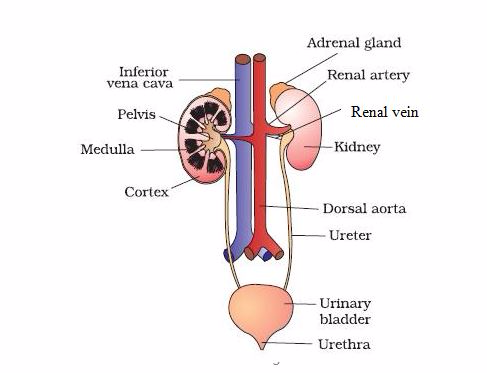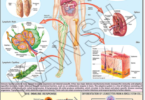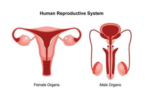TOPIC 4: EXCRETION | BIOLOGY FORM 3
Concept of Excretion
The Concept of Excretion
Explain the concept of excretion
Chemical reactions occur in the cells of living organisms all the time to carry out the life processes. The sum of these reactions is called metabolism.
Metabolism produces useful products as well as toxic (poisonous)
by-products.
Metabolism produces useful products as well as toxic (poisonous)
by-products.
These toxic substances have to be removed as they are harmful if allowed to accumulate. The removal of metabolic waste products from the body of an organism is known as excretion.
The major excretory products are carbon dioxide, excess water, and nitrogenous compounds like ammonia, urea, uric acid, etc. Carbon dioxide and water are produced in the process of tissue respiration.
Nitrogenous compounds are formed from the breakdown of proteins and
amino acids. Water and salts in excess of the body’s needs are also
excreted.
Nitrogenous compounds are formed from the breakdown of proteins and
amino acids. Water and salts in excess of the body’s needs are also
excreted.
Other
excretory products include chemicals from medicines, toxic substances,
and circulating hormones that have already served their purpose. We will
learn how metabolic wastes get eliminated.
excretory products include chemicals from medicines, toxic substances,
and circulating hormones that have already served their purpose. We will
learn how metabolic wastes get eliminated.
TOPIC 4: EXCRETION | BIOLOGY FORM 3
In
concise, excretion is the process by which waste products of metabolism
and other non-useful materials are eliminated from an organism.
concise, excretion is the process by which waste products of metabolism
and other non-useful materials are eliminated from an organism.
Examples of Excretory Products Eliminated by Organisms
Give examples of excretory products eliminated by organisms
Living
organisms excrete various excretory products of diverse chemical
nature. The following are examples of excretory products excreted by
living organisms:
organisms excrete various excretory products of diverse chemical
nature. The following are examples of excretory products excreted by
living organisms:
- Carbon dioxide:This
is a by-product of respiration of both plants and animals. It is
excreted through the pores of the stomata in plants (some of the carbon
dioxide produced by respiration is used in photosynthesis). In man,
carbon dioxide is eliminated from the body by lungs. - Water:The
concentration of water in cells must be kept within narrow limits. Too
little or too much water can have a negative effect on the osmotic
condition in and around the cell. Therefore, it has to be regulated.
Plant cells are protected from bursting by their cell walls. Animals do
not have cell walls, and will burst if they have too much water. Excess
water is lost from the surface of gaseous exchange in both plants and
animals. In mammals, water is also lost through sweat and through
osmoregulation controlled by the kidneys. - Urea:This
is a compound produced in mammals from the breakdown of excess amino
acids. Amino acids cannot be stored because their accumulation is toxic.
They are therefore converted into a less toxic substance. This process
occurs in the liver and is called de-amination.Ammonia is converted to
urea by the liver. Urea is transported by blood to the kidneys where
they are excreted. The kidneys are also used to remove uric acid, water,
excess salts, excess hormones and bile pigments. - Calcium oxalate:This
is a waste material produced by plants and is stored as an insoluble
crystalline structure in the cells. Calcium oxalate is stored in aging
leaves, stems and roots, flowers or fruits. - Oxygen:Through
the process of photosynthesis, oxygen is produced as a by-product. Some
of the oxygen is used for respiration, and the remainder is excreted
through the stomata of the leaves.In plants, some waste substances are
stored in parts of the plant that are dead. Examples of this are the
tannin in the bark of trees such as mangroves and the dyes in the
heartwood of trees such as logwood. The purpose of the storage of waste
material ranges from protection to a decreased risk of being consumed.
Excretion in Human
The
main excretory system in humans is the urinary system. The skin also
acts as an organ of excretion by removing water and small amounts of
urea and salts (as sweat). The urinary system includes a pair of
bean-shaped kidneys located in the back of the abdominal cavity.
main excretory system in humans is the urinary system. The skin also
acts as an organ of excretion by removing water and small amounts of
urea and salts (as sweat). The urinary system includes a pair of
bean-shaped kidneys located in the back of the abdominal cavity.
Excretory Organs in Human Being
Mention excretory organs in human being
There
are special organs concerned with removal of excretory products from
the body. Such organs are called excretory organs. The excretory organs
in an animals body are the kidney, the skin the lungs and the liver. The
following table shows the excretory organs and the products they
excrete.
are special organs concerned with removal of excretory products from
the body. Such organs are called excretory organs. The excretory organs
in an animals body are the kidney, the skin the lungs and the liver. The
following table shows the excretory organs and the products they
excrete.
The
table below summarizes excretory products in humans and the organs
concerned with excretion of the product and the mode of excretion.
table below summarizes excretory products in humans and the organs
concerned with excretion of the product and the mode of excretion.
| Excretory product | Organ | Mode of excretion |
| Carbon dioxide | Lungs | Exhalation |
| Urea and excess mineral salts | Kidneys | Urine |
| Skin | Sweat | |
| Excess water | Kidneys | Urine |
| Skin | Sweat | |
| Lungs | Water vapour | |
| Bile pigments (from breakdown of haemoglobin) | Liver | Faeces |
A
comparison between different excretory products can be made. Following
is the comparison between different types of excretory products:
comparison between different excretory products can be made. Following
is the comparison between different types of excretory products:
| Waste | Advantages | Disadvantages | Habitat | Excreted by |
| Ammonia | Produced with little energy | Toxic in concentrated solution. Excretion take place in lot of water | Water | Marine and fresh water invertebrates, bony fishes, amphibians |
| Urea | Less toxic than ammonia. Less water is needed to excrete it | Requires more energy to produce it | Land, Sea | Adult amphibians, turtles, mammals and bony fishes |
| Uric Acid | Very little water is used for its excretion | Requires considerable energy to produce it | Land | Reptiles, birds, insects, gastropods (snails and slugs) |
| Guanine | Relatively non toxic. Less water is used to excrete it | More energy is needed | Arid habitat | Scorpions, Spiders |
The excretory organs in humans beings may conventionally be put into two groups namely, primary and accessory organs:
Primary excretory organs
- Kidneys:Kidneys
are bean-shaped organs of a reddish brown colour that are found in the
sides of the vertebral column. Once the body has extracted wastes from
food, it sends the wastes to the kidneys. The kidneys filter the wastes,
including urea, salt and excess water, which are flushed out of the
body as urine. - Skin:The skin performs
its excretory function via the sweat glands. These are coiled tubules
surrounded by blood capillaries. These glands produce sweat that
contains mineral salts, excess oils, water, and traces of urea and
lactic acid from the surrounding blood vessels which are then excreted
out of the body through sweat pores. The tubules extend into sweat ducts
which open on the surface of the skin as pores. Sweating also helps to
cool the body during evaporation. - Lungs:The
lungs are very important excretory organs as they expel carbon dioxide
from the body via exhalation. The lungs use cells known as alveoli to
remove the carbon dioxide from our blood. Otherwise, the carbon dioxide
would accumulate and have a detrimental effect to our body.
Accessory excretory organs
- Liver:Although
considered a secondary or accessory excretory organ, the liver plays a
vital part in keeping the body clean. Amino acids are the end-product of
proteins. Excess amino acids cannot be stored in the body. They are
taken from the gut into the liver by the hepatic portal vein. The liver
converts them into useful carbohydrates (stored in the form of glycogen)
and ammonia. Ammonia is very poisonous and must be removed from the
body. The liver converts ammonia into a harmless compound called urea.
Urea dissolves in the blood and is transported into the kidney via the
hepatic vein where it is removed as component of urine.Harmful poisons
and chemicals that are either produced in the body or consumed are
broken down and detoxified by the liver. - Gall bladder:Although
the gallbladder does not have a highly significant role to play in the
excretory system, it does have a function that assists the overall
process. Bile, a liquid produced by the liver to break down waste, is
first stored in the gall bladder. When needed, it is discharged into the
small intestine whose role is to break down fats, ethanol and other
acidic wastes. - Urinary bladder:The
waste fluid that is created in the liver and collected in the kidney is
transferred into the urinary bladder where it is temporarily stored
until the individual urinates. The urinary bladder provides a short term
solution for storing urine in the body until it is ultimately
discharged. - Ureters:The ureters tubes
of smooth muscle fibre transfer liquid waste from the kidneys into the
urinary bladder. The urine is moved with peristaltic movements which
force the urine away from the kidneys. The ureters also have
ureterovesical valves which ensure the waste fluid does not travel back
into the kidney. - Urethra:The urethra
runs through the penis in males, and serves as a carrier of semen as
well as urine for their ultimate discharge out of the body. The urethra
tube is shorter in females and is just above the vaginal opening. - Large intestine:Food
particles are absorbed into the blood stream via the small intestine.
The undigested substances are transferred to the large intestine which
essentially serves as a storage organ for the excretory products. The
descending, ascending and transverse colons also facilitate the
absorption of leftover vitamins, water and salt. The distal straight
section (known as the rectum) is used for the storage of waste products
(faeces) before they are excreted from the body via the anal canal with
the help of internal and external sphincters.
The Urinary System and its Adaptive Features
Describe the urinary system and its adaptive features
The
urinary system is a system concerned with production, storage and
removal of urine. In humans, it is made up of the two kidneys, ureters,
blood vessels that join them, urinary bladder and urethra.
urinary system is a system concerned with production, storage and
removal of urine. In humans, it is made up of the two kidneys, ureters,
blood vessels that join them, urinary bladder and urethra.
Each
kidney is connected to a urinary bladder by a tube called the ureter.
As urine is formed, it passes through the ureter to the urinary bladder
where it is stored temporarily. Below the bladder is a tube called
urethra which is surrounded by a ring of muscles called sphincter
muscles. The urethra is a canal that carries urine from the bladder and
expels it outside the body. The urethra passes urine when sphincter
muscles relax.
kidney is connected to a urinary bladder by a tube called the ureter.
As urine is formed, it passes through the ureter to the urinary bladder
where it is stored temporarily. Below the bladder is a tube called
urethra which is surrounded by a ring of muscles called sphincter
muscles. The urethra is a canal that carries urine from the bladder and
expels it outside the body. The urethra passes urine when sphincter
muscles relax.
The kidneys:Kidneys
are bean-shaped organs that are deep red in colour located on the
dorsal part of the abdominal cavity. Mammals have one pair of kidneys.
Kidneys are the principle organs of the urinary system.
are bean-shaped organs that are deep red in colour located on the
dorsal part of the abdominal cavity. Mammals have one pair of kidneys.
Kidneys are the principle organs of the urinary system.
Functions of the kidneys
- They filter blood to remove wastes and reabsorb useful substances such as water and salts.
- They maintain appropriate water-salt balance in the blood.
- They regulate the acid-base balance such that the pH of blood remains at about 7.4 for proper functioning of the body.
- They are important in regulation of blood pressure.
- They
produce erythropoietin, calcitriol and an enzyme called rennin, which
is involved in the formation of the hormone, angiotensin, which raises
blood pressure. Erythropoietin is a hormone that speeds up the process
of the formation of red blood cells in the bone marrow. Calcitriol is an
active form of vitamin D which increases the rate of calcium
reabsorption for bone formation.
Structure of the kidney
Each
kidney is enclosed in a thin, fibrous covering called the capsule. The
kidney has three distinct regions, namely the cortex, medulla and
pelvis. The cortex is the outermost layer of the kidney. The medulla is
the middle layer of the kidney, normally red in colour. The pelvis is
the space inside the kidney which collects the urine and leads it to the
ureter. The ureter passes urine to the urinary bladder where it is
stored before it is released out through the urethra in the genitals.
kidney is enclosed in a thin, fibrous covering called the capsule. The
kidney has three distinct regions, namely the cortex, medulla and
pelvis. The cortex is the outermost layer of the kidney. The medulla is
the middle layer of the kidney, normally red in colour. The pelvis is
the space inside the kidney which collects the urine and leads it to the
ureter. The ureter passes urine to the urinary bladder where it is
stored before it is released out through the urethra in the genitals.
Each
kidney is supplied with oxygen-rich blood from the renal artery.
Deoxygenated blood is returned to the circulatory system from the
kidneys via the renal vein. Blood entering the kidneys from the renal
artery are rich in waste materials, and blood exiting the kidneys from
the renal vein is deficient in these waste materials.
kidney is supplied with oxygen-rich blood from the renal artery.
Deoxygenated blood is returned to the circulatory system from the
kidneys via the renal vein. Blood entering the kidneys from the renal
artery are rich in waste materials, and blood exiting the kidneys from
the renal vein is deficient in these waste materials.
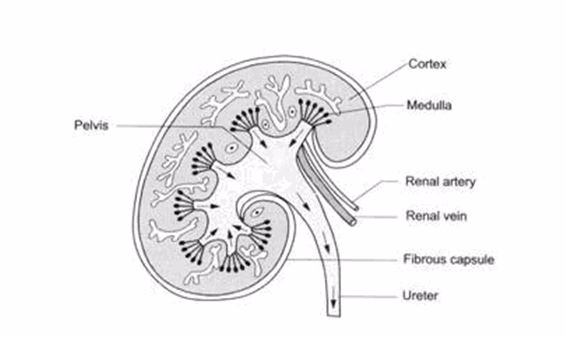
Structure of the kidney
The nephron
Each
kidney is made up of numerous, coiled excretory tubules known as
nephrons, and collecting ducts associated with tiny blood vessels.
kidney is made up of numerous, coiled excretory tubules known as
nephrons, and collecting ducts associated with tiny blood vessels.
A
nephron consists of a long, coiled tubule, and the Malpighian
corpuscle. The tubule of the nephron is differentiated into the proximal
convoluted tubule, loop of Henle and the distal convoluted tubule. The
distal tubule opens into the collecting duct.
nephron consists of a long, coiled tubule, and the Malpighian
corpuscle. The tubule of the nephron is differentiated into the proximal
convoluted tubule, loop of Henle and the distal convoluted tubule. The
distal tubule opens into the collecting duct.
At
the proximal end of the nephron is the Malpighian corpuscle, which
consists of Bowman’s capsule and the glomerulus. Bowman’s capsule is a
double-walled, cup-like structure which surrounds the dense network of
blood capillaries called the glomerulus.
the proximal end of the nephron is the Malpighian corpuscle, which
consists of Bowman’s capsule and the glomerulus. Bowman’s capsule is a
double-walled, cup-like structure which surrounds the dense network of
blood capillaries called the glomerulus.
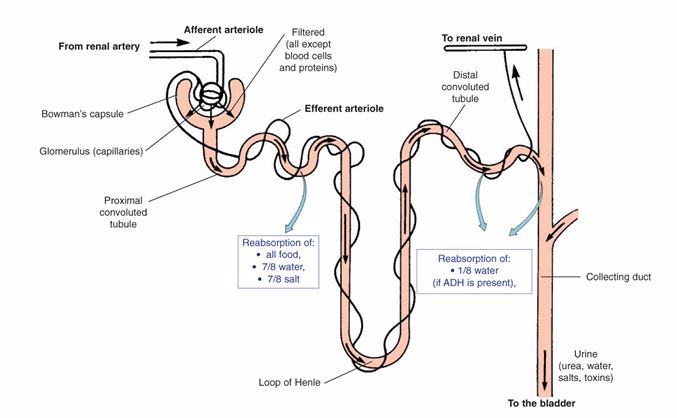
Structure of the nephron
There is a branch of the renal artery,the afferent arteriole,
entering the small cup-like space of theBowman’s capsuleas a network of
blood capillaries. This network is known as theglomerulus. Emerging
from this network, the capillaries re-unite to form a small arteriole,
known asthe efferent arteriole. As the efferent
arteriole continues it twines around the proximal and distal convoluted
tubule. The efferent arteriole divides into capillaries at several
points along the length of the tubules, absorbing various substances.
These capillaries eventually reunite to drain into the renal vein. The
efferent arteriole is smaller than the afferent arteriole. This
difference in diameter helps to raise the glomerular pressure and aids
in ultra filtration.
entering the small cup-like space of theBowman’s capsuleas a network of
blood capillaries. This network is known as theglomerulus. Emerging
from this network, the capillaries re-unite to form a small arteriole,
known asthe efferent arteriole. As the efferent
arteriole continues it twines around the proximal and distal convoluted
tubule. The efferent arteriole divides into capillaries at several
points along the length of the tubules, absorbing various substances.
These capillaries eventually reunite to drain into the renal vein. The
efferent arteriole is smaller than the afferent arteriole. This
difference in diameter helps to raise the glomerular pressure and aids
in ultra filtration.
Some
animals do not have a well developed kidney; they may have structures
called nephridia. Animals such as earthworms that are simple tube-like
structures have nephridia that have the same role as the more complex
nephrons in the kidneys.
animals do not have a well developed kidney; they may have structures
called nephridia. Animals such as earthworms that are simple tube-like
structures have nephridia that have the same role as the more complex
nephrons in the kidneys.
The Process of Urine Formation
Explain the process of urine formation
The
blood from the afferent arteriole, which enters the Bowman’s capsule,
is rich in nutrients such as glucose, fatty acids, amino acids,
blood from the afferent arteriole, which enters the Bowman’s capsule,
is rich in nutrients such as glucose, fatty acids, amino acids,
vitamins, proteins, urea and excess salts. A nephron is the structural
and functional unit of a kidney which is concerned with excretion and
haemostasis.
The
three (3) distinct stages of urine formation are: (1) glomerular
filtration, (2) tubular reabsorption and secretion, and (3) water
conservation
three (3) distinct stages of urine formation are: (1) glomerular
filtration, (2) tubular reabsorption and secretion, and (3) water
conservation
- Glomerular filtration:Filtration
occurs in the glomerulus (plural; glomeruli). Because the lumen of the
afferent arteriole is significantly smaller than the efferent arteriole
there is a large amount of pressure in the glomerulus. This pressure
forces forces plasma, the liquid portion of the blood, through the
capillary walls in the glomerulus. The plasma contains water, glucose,
amino acids, urea, salts, uric acid, vitamins, and hormones. Red blood
cells and proteins are retained in the blood capillaries because they
are too large to pass through the wall. This process is called
ultra-filtration and the fluid which passes into the Bowman’s capsule is
known as the glomerular filtrate.The glomerular filtrate collects in
the capsule and enters the renal tubule at the proximal convoluted
tubule which is coiled to increase the surface are for reabsorption of
substances. - Reabsorption and secretion:The
efferent arteriole branches into capillaries which surround the proximal
convoluted tubule. There, glucose, amino acids, vitamins, hormones and
about 80% of sodium chloride and water are reabsorbed into the blood
capillaries. Only the substances that are useful to the body are
reabsorbed. This is referred to as selective reabsorption. Normally 100%
of glucose is reabsorbed. Blood cells are not reabsorbed due to their
large molecular size. Reabsorption involves both diffusion and active
transport (against concentration gradient), which uses energy in the
form of ATP. The waste-containing fluid that remains after reabsorption
is urine. Tubular secretion is the passage of certain substances out of
the capillaries directly into the renal tubules. Tubular secretion is
another way of getting waste materials into the urine. For example,
drugs such as penicillin and phenobarbital are secreted into the renal
tubules from the capillaries. Urea and uric acid that may have been
reabsorbed are secreted. Excess potassium ions are also secreted into
the urine. Tubular secretions also maintain the pH of the blood. - Water conservation:In
the distal convoluted tubule, water is reabsorbed into the blood by
osmosis. The tubule is also highly coiled to increase the surface area
for reabsorption. The glomerular filtrate then flows into the collecting
tubules where more water is reabsorbed. The filtrate now called urine
flows into the collecting duct then into the pelvis of the kidney. It
then flows into the ureter and is temporarily stored in the bladder.
When it gets full, impulses are sent to the brain to create an awareness
of the presence of urine in the bladder. A person then fells the need
to urinate and the bladder muscles contract, sphincter muscles relax and
the urine is expelled via the urethra.Urine formation is essential for
maintaining homeostasis, which is the ability of the body to maintain
constant internal environment.
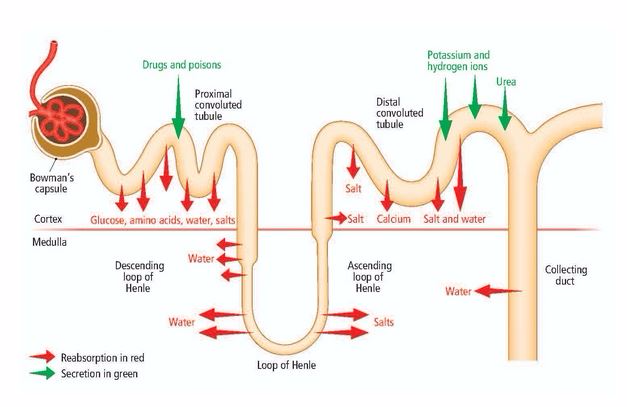
Reabsorption and secretion by the nephron
Adaptations of the urinary system to its functions
- The
urinary system has a large afferent arteriole, and narrow efferent
arteriole, which allows build up of pressure, thus facilitating
ultra-filtration. - The glomerulus capillaries are highly coiled
and semi permeable, causing a build up of pressure in the glomerulus
hence ultrafiltration. - The glomerular capillaries are semi
permeable (tubule also semi permeable) to allow selective movement of
materials in and out of the nephron (selective reabsorption). - The
tubules’ epithelium is thin (1 cell thick) to reduce diffusion distance
for faster passage and hence reabsorption of materials; and they are
and leakier than normal capillaries. - It is connected to a
collecting duct, which channels the filtrate (urine) out of the nephron
to the ureter to allow for continous functioning of the nephron. - The
proximal convoluted tubule and the distal convoluted tubule are coiled
so as to increase the nephrons’s length and hence more surface area for
efficient reabsorption to take place. - The Bowman’s capsule is cup-shaped to provide maximum surface area for filtration.
- The tubule is supplied with a network of blood capillaries for maximum reabsorption.
- The nephrons are numerous in number for efficient excretion of waste products.
Complications and Disorders of the Excretory System
Common Complications and Disorders of the Excretory System
Mention common complications and disorders of the excretory system
A
large number of medical conditions of varying intensity are associated
with the excretory system. If these are not addressed immediately, they
may even prove to be fatal and claim one’s life. We need to be well
acquainted with the most commonly occurring diseases of excretory system
along with their description, symptoms and effective treatment
measures. The table below shows some of the common complications and
disorders of the excretory system, their causes, symptoms, effects and
preventive measures.
large number of medical conditions of varying intensity are associated
with the excretory system. If these are not addressed immediately, they
may even prove to be fatal and claim one’s life. We need to be well
acquainted with the most commonly occurring diseases of excretory system
along with their description, symptoms and effective treatment
measures. The table below shows some of the common complications and
disorders of the excretory system, their causes, symptoms, effects and
preventive measures.
The Causes, Symptoms, Effects and Control Measures of Common Complications and Disorders of the Excretory System
Explain the causes, symptoms, effects and control measures of common complications and disorders of the excretory system
Disorders of the Excretory System
| Disease | Cause(s) | Symptoms | Effects | Prevention/treatment |
| Kidney (renal) failure – failure of the kidney to function adequately due to partial or entire destruction of nephrons |
|
|
Bone damage, muscle paralysis, abnormal heart rhythm, loss of memory, pain in the back or side and if not treated earlier, can lead to death if it involves both kidneys |
|
| Kidney stones |
|
|
|
|
| Urinary tract infections (UTIs) |
|
|
|
|
| Liver cirrhosis: a condition in which liver cells degenerate and are replaced by scar tissue, causing the liver to shrink, harden, become fibrous and fail to function normally |
|
|
|
|
| Hepatitis:Inflammation of the liver |
|
|
|
|
| Bladder Cancer |
|
|
|
Excretion in Plants
Types of Excretory Products Eliminated by Plants
Mention types of excretory products eliminated by plants
Excretion
occurs in plants and animals as they both have waste products to be
removed from their bodies. Compared to animals, plants do not have a
well-developed excretory system to throw out nitrogenous waste
materials. This is because of the differences in their physiology.
Therefore, plants use different strategies for excretion.
occurs in plants and animals as they both have waste products to be
removed from their bodies. Compared to animals, plants do not have a
well-developed excretory system to throw out nitrogenous waste
materials. This is because of the differences in their physiology.
Therefore, plants use different strategies for excretion.
Plants
eliminate some waste through diffusion. During the day, excess oxygen
gas produced by photosynthesis is released through the stomata. Carbon
dioxide produced by respiration is normally used up during
photosynthesis. At night, however, as photosynthesis slows down, carbon
dioxide is not used up as fast as it is produced, and it is released as a
waste product. Plants also produce oxygen as a by-product of
photosynthesis. The oxygen that is not used for respiration is also
excreted through the stomata.
eliminate some waste through diffusion. During the day, excess oxygen
gas produced by photosynthesis is released through the stomata. Carbon
dioxide produced by respiration is normally used up during
photosynthesis. At night, however, as photosynthesis slows down, carbon
dioxide is not used up as fast as it is produced, and it is released as a
waste product. Plants also produce oxygen as a by-product of
photosynthesis. The oxygen that is not used for respiration is also
excreted through the stomata.
Excess
water evaporates mostly from stomata and also from the outer surface of
the stem, fruits, etc., throughout the day. This process of getting rid
of excess water is called transpiration.
water evaporates mostly from stomata and also from the outer surface of
the stem, fruits, etc., throughout the day. This process of getting rid
of excess water is called transpiration.
Many
plants store organic waste products in their permanent tissues that
have dead cells, e.g., in heartwood. Plants also store waste within
their leaves or barks. These wastes are periodically removed as the
leaves and barks fall off.
plants store organic waste products in their permanent tissues that
have dead cells, e.g., in heartwood. Plants also store waste within
their leaves or barks. These wastes are periodically removed as the
leaves and barks fall off.
Some
of the waste products are stored in special cells or cellular vacuoles.
Various waste products such as tannins, essential oils, gums, resins,
etc., are produced during catabolic processes. Tea leaves contain
tannin. Tannins are found also in the barks of trees.
of the waste products are stored in special cells or cellular vacuoles.
Various waste products such as tannins, essential oils, gums, resins,
etc., are produced during catabolic processes. Tea leaves contain
tannin. Tannins are found also in the barks of trees.
The
leaves of many plants, like Eucalyptus, lemon, etc., contain essential
oils. The coating of oranges and lemons and the petals of flowers like
rose and jasmine also contain oils. Some plant wastes are stored as a
thick, white fluid. You may have seen white fluid ooze out when you
pluck a papaya or a fig or other plants. This white fluid is called
latex.
leaves of many plants, like Eucalyptus, lemon, etc., contain essential
oils. The coating of oranges and lemons and the petals of flowers like
rose and jasmine also contain oils. Some plant wastes are stored as a
thick, white fluid. You may have seen white fluid ooze out when you
pluck a papaya or a fig or other plants. This white fluid is called
latex.
Gums
are a group of sticky, water- soluble wastes found in the common gum
tree. Resins are another group of wastes found commonly in the stems of
conifers (e.g., pine, fir).
are a group of sticky, water- soluble wastes found in the common gum
tree. Resins are another group of wastes found commonly in the stems of
conifers (e.g., pine, fir).
Alkaloids
are a group of toxic waste products. But some of these are useful to
us. Quinine and morphine are medicines derived from alkaloids stored in
Cinchona bark and opium poppy flowers respectively. Caffeine found in
coffee seeds and nicotine in tobacco leaves is also alkaloids.
are a group of toxic waste products. But some of these are useful to
us. Quinine and morphine are medicines derived from alkaloids stored in
Cinchona bark and opium poppy flowers respectively. Caffeine found in
coffee seeds and nicotine in tobacco leaves is also alkaloids.
Plants
also eliminate waste by the accumulation of waste in the vacuoles of
the aging leave cells. These leaves will eventually die and fall off,
removing waste in the process. This process is called abscission.
also eliminate waste by the accumulation of waste in the vacuoles of
the aging leave cells. These leaves will eventually die and fall off,
removing waste in the process. This process is called abscission.
Organic
acids, which might prove harmful to plants, often combine with excess
cations and precipitate out as insoluble crystals that can be safely
stored in plant cells. Calcium oxalate crystals accumulate in some
tubers like yam.
acids, which might prove harmful to plants, often combine with excess
cations and precipitate out as insoluble crystals that can be safely
stored in plant cells. Calcium oxalate crystals accumulate in some
tubers like yam.
Aquatic
plants lose most of their metabolic wastes by direct diffusion into the
water surrounding them. Terrestrial plants excrete some waste into the
soil around them.
plants lose most of their metabolic wastes by direct diffusion into the
water surrounding them. Terrestrial plants excrete some waste into the
soil around them.
In
plants, breakdown of substances is much slower than in animals. Plants
do not have specialized excretory organs for the removal of metabolic
wastes.
plants, breakdown of substances is much slower than in animals. Plants
do not have specialized excretory organs for the removal of metabolic
wastes.
Plants do not need a specialized excretory system like in animals because of the following reasons:
- The rate of producing waste products in plants is much lower.
- Most
excretory products from plants are removed by diffusion through the
stomata or lenticels. Lenticels are areas in woody stems where the cells
are loosely packed allowing gaseous exchange and removal of waste
products. - The major excretory products of plants are carbon
dioxide, oxygen and water. These products are recycled. For example, the
oxygen released as a by product during photosynthesis, is used in
respiration by animals and plants. The carbon dioxide released during
respiration is used for photosynthesis by the plants. Water is released
into the atmosphere where it enters the water cycle. - Plants produce less poisonous substances compared to the nitrogenous wastes produced by animals.
- Plants
have large vacuoles which store waste substances often accumulating at
concentrations that lead to crystal formation in form of oil droplets or
granules. - Plants can also store the waste products in organs
that are destined to fall or die off. So they can be excreted via
abscission. Other waste material such as resins, saps and latexes are
forced out from the interior of some plants by hydrostatic pressure
inside the plant.
The Importance of Common Excretory Products of Plants
Explain the importance of common excretory products of plants
Have
you ever noticed sticky, milky or oily substances being oozed from the
bark of trees? These are excretory products and may be resins, gums,
latex and or other excretory products. These products may be poisonous.
However, many have found use in everyday life of humans, such as latex
which is used to produce gloves and clothing. The table below shows
functions of some plant waste products.
you ever noticed sticky, milky or oily substances being oozed from the
bark of trees? These are excretory products and may be resins, gums,
latex and or other excretory products. These products may be poisonous.
However, many have found use in everyday life of humans, such as latex
which is used to produce gloves and clothing. The table below shows
functions of some plant waste products.
| Product (waste) | Plant source | Use and effects |
| 1. Tannins | Dead tissues of plants such as acacia, conifers, coffee and mangroves. |
|
| 2. Alkaloids: Are nitrogenous excretory products in plants and occur in various forms- Common alkaloids include: | ||
| (a) Caffeine and theophilinet | -Coffee fruits and tea leaves | -Mild stimulants to increase mental activity and reduce fatigue. |
| (b)Quinine | – Bark of cinchona tree. | -A drug for the treatment of malaria.-An additive in drinks to act as a stimulant. |
| (c) Cocaine | – Leaves of coca plant |
|
| (d) Cannabis | -Fruits, flowers and leaves of cannabis sativa (bhang or marijuana) |
|
| (e) Opiates(morphine) | -Opium poppy | Manufacture of drugs like morphine and codeine both of which are effective painkillers, muscle relaxant, cough suppressants, and anti-diarrhoeal. |
| (f) Nicotine | -Tobacco leaves. |
|
| (g) Papain | -Epicarp of pawpaw fruits (especially raw). | -Has proteolytic activity hence used as a meat tenderizer. |
| (h) Colchicine | -Roots of the crocus plant. |
|
| (i) Pyrethrins | -Flowers of pyrethrum | Making of insecticides |
| (j) Khat (miraa) mirungi) | -Leaves and twigs of the “khat” plat | -Used as a stimulant. |
| 3. Latex |
|
|
| 4. Gums | Different plants such as Arabic ghath and carob, acacia tree, etc. |
|
| 5. Anthocyanins | -Petals and leaves of various plants, and are mostly red, blue or purple. |
|
| 6.Digitalis glycosides | -Foxglove | Manufacture of drugs used for treatment of heart diseases such as digitoxin. |
| 7. Rennin | -Certain tree stems like the casuarina tree | -Manufacture of varnish and gum. |
| 8. Oil | -Flowers or leaves of certain trees. | Manufacture of perfume and ointment for insect bites. |
Post Views: 77


